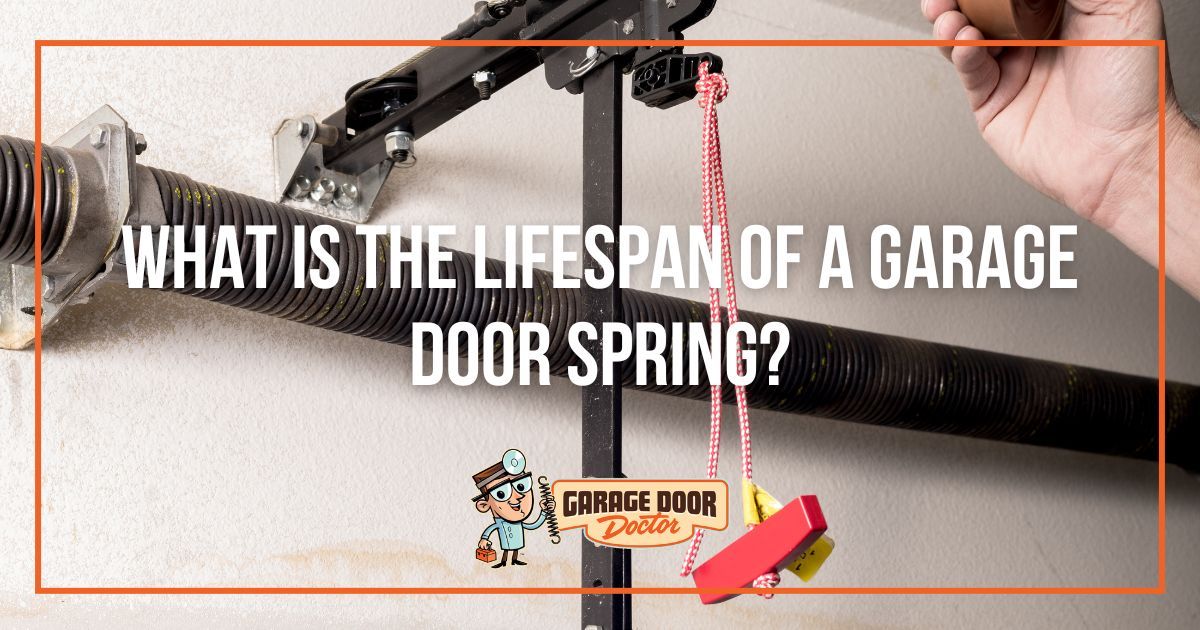
Your garage door can’t properly lift or lower without a sturdy spring system. Regular maintenance promotes a smoother operation, but the springs will still experience natural wear and tear before they break. This begs the question: What is the lifespan of a garage door spring?
Our experts reveal everything you need to know about the life expectancy of this equipment, the factors that cause it to break, and much more in this helpful guide.
Understanding Torsion Springs vs. Extension Springs: Their Purpose and Lifespan
Every time your garage door opener motor opens, lifts, and then lowers the mechanism, it counts as one cycle. Technically speaking, most garage door springs have a life expectancy of about 10,000 cycles. However, you may not have to replace the equipment once you reach this milestone, depending on the type of springs your system uses.
Having the right springs for your type of door makes a huge difference in their overall life expectancy. So, what is the lifespan of a garage door spring? Let’s explore the two common types below:
- Extension springs sit along the sides of the door and have an average cycle life between 7,000 and 10,000 cycles. They most often appear in single-car garages.
- Torsion springs appear horizontally above the door and can last anywhere between 10,000 and 20,000 cycles or an average of seven to 12 years. These high-cycle springs work best if you have a heavy door, like one for a two-car garage.
What Causes a Broken Garage Door Spring?
It doesn’t matter if your garage door features extension or torsion springs. Both options will only last for so long, though the following factors may exacerbate a spring’s natural wear:
- Frequent use: A homeowner who operates their door multiple times a day will have to replace the springs sooner than a homeowner who rarely uses their garage door.
- Weather conditions: High heat and humidity promote rust, corrosion, and reduced elasticity on springs. Cold weather also impacts the metal and may make torsion or extension springs brittle.
- Lack of maintenance: Your door will struggle with heavy lifting if you don’t perform prompt spring repair and maintenance.
Continue Reading: Why Do Garage Door Springs Break?
Signs You Need a Garage Door Spring Replacement
Along with, “What is the lifespan of a garage door spring?” many homeowners wonder, “When should I replace garage door springs?” The timeline for replacing springs ultimately depends on the kind your door uses and your maintenance efforts.
Experts agree that you should replace the door’s springs when you experience the following issues:
- Loud creaking or snapping noises: Your garage door shouldn’t make unusual sounds during operation. These noises often indicate a spring breaking.
- The door quickly slams shut: The springs likely can’t support the door’s weight anymore.
- The door appears crooked: Your high-tension extension springs could be wearing the point of replacement.
- Lifting the garage door becomes difficult: Once garage door springs break or weaken, it’s extremely tough to lift the door overhead.
Don’t hesitate to contact garage door repair contractors at the first sign of trouble. They’ll inspect the system and replace the faulty equipment for peace of mind.
Helpful Article: 5 Signs of a Broken Garage Door Spring 🔗
Follow These Tips for Addressing a Broken Garage Door Spring
Act fast as soon as you notice the signs of a spring breaking. To avoid further damage, avoid operating the system until experts can perform garage door spring repair or replacement. Even if you have the proper tools, never attempt DIY repairs, as this comes with a risk of injury and extensive damage to the garage door.
Experts have the proper training to tackle a wide range of garage door issues. They’ll make sure new springs are properly installed and provide maintenance tips for a longer lifespan.
Once you have new springs mounted near the garage door, make a plan to preserve them. Lubricate them every three to six months and periodically check for door alignment issues. It’s also wise to book professional inspections once a year to rule out major issues.
When Garage Door Springs Break, Call Garage Door Doctor
After reading this guide, you no longer have to wonder, “What is the lifespan of a garage door spring?” If your garage door system suddenly malfunctions due to a broken spring, damaged safety cables, or other issues, our team is ready to step in and perform repairs.
Garage Door Doctor is your go-to source for garage door repair in Bloomington, Indiana and the surrounding areas. Turn to us for proper maintenance solutions to prevent wear and tear. Call (317) 342-4995 to request a service today!

